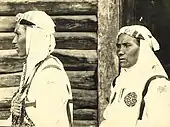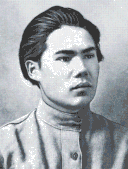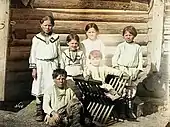Chuvash people
The Chuvash people (UK: /ˈtʃuːvɑːʃ/ CHOO-vahsh,[15] US: /tʃʊˈvɑːʃ/ chuu-VAHSH;[16] Chuvash: чӑваш [tɕəˈʋaʃ]; Russian: чуваши [tɕʊˈvaʂɨ]) are a Turkic ethnic group, a branch of Oghurs, native to an area stretching from the Volga-Ural region to Siberia. Most of them live in Chuvashia and the surrounding areas, although Chuvash communities may be found throughout the Russian Federation. They speak Chuvash, a unique Turkic language that diverged from other languages in the family more than a millennium ago.
Чӑваш, Çăvaš, Чӑвашсем, Çăvašsem | |
|---|---|
 Chuvash people at a school, in the traditional clothing | |
| Total population | |
| 1.5 million[1] | |
| Regions with significant populations | |
| 1,435,872[2][3] | |
| 22,305[4] | |
| 10,593[5] | |
| 10,074[6] | |
| 2,281[7] | |
| 2,242[8] | |
| 1,204[9] | |
| 900 | |
| 848[10] | |
| 542[11] | |
| 534[12] | |
| 489[13] | |
| 373[14] | |
| Languages | |
| Chuvash Russian | |
| Religion | |
| Predominantly Orthodox Christianity Minority Vattisen Yaly, Sunni Islam | |
| Related ethnic groups | |
| Volga Tatars, Mari, Besermyan | |
Etymology
There is no universally accepted etymology of the word Chuvash, but there are three main theories. The popular theory accepted by Chuvash people suggests that Chuvash is a Shaz-Turkic adaptation of Lir-Turkic Suvar (Sabir people), an ethnonym of people that are widely considered to be the ancestors of modern Chuvash people.[17] Compare Lir-Turkic Chuvash: huran to Shaz-Turkic Tatar: qazan (‘cauldron’).[18] One theory suggests that the word Chuvash may be derived from Common Turkic jăvaš ('friendly', 'peaceful'), as opposed to şarmăs ('warlike') Another theory is that the word is derived from the Tabghach, an early medieval Xianbei clan and founders of the Northern Wei dynasty in China. The Old Turkic name Tabghach (Tuoba in Mandarin) was used by some Inner Asian peoples to refer to China long after this dynasty. Gerard Clauson has shown that through regular sound changes, the clan name Tabghach may have transformed to the ethnonym Chuvash.[19]
Subgroups
The subdivision of the Chuvash people are as below:
- Virjal or Turi (Chuvash: вирьял, тури, 'upper')
- Anat jenchi (анат енчи, 'mid-lower')
- Anatri (анатри, 'lower')
- Hirti (хирти, 'steppe') (this is a sub-group that is recognized by some researchers)
Phenotypically, there is no particular differences among the Chuvash, as more Caucasoid or more Mongoloid phenotypes can be found among all subgroups.[20][21]
History

The Turkic ancestors of the Chuvash people are believed to have come from central Siberia, where they lived in the Irtysh basin (between Tian Shan and Altay) from at least the end of the third millennium BC. In the early first century AD the Bulgars started moving west through Zhetysu and the steppes of modern-day Kazakhstan, reaching the North Caucasus in the 2nd to 3rd centuries AD. There they established several states (Old Bulgaria on the Black Sea coast and the Suar Duchy in modern-day Dagestan).
Old Bulgaria broke up in the second half of the 7th century after a series of successful Khazar invasions. Some of its population fled north, to the Volga-Kama region, where they established Volga Bulgaria, which eventually became extremely wealthy: its capital then being the 4th-largest city in the world. Shortly after that, the Suar Duchy was forced to become a vassal state of Khazaria. About half a century later, the Suars took part in the Arab–Khazar wars of 732–737. The adoption of Islam in the early tenth century in Volga Bulgaria led to most of its people embracing that religion.[22]
After the Mongols destroyed Volga Bulgaria in 1236, the Golden Horde kept control of the region until its slow dissolution from c. 1438. The Kazan Khanate then became the new authority of the region and of the Chuvash. The modern name "Chuvash" began to appear in records starting from the sixteenth century from Russian and other foreign sources.[22]
.png.webp)
In 1552, the Russians conquered the Kazan Khanate and its territories. The Chuvash, required to pay yasak, gradually became dispossessed of much of their land. Many Chuvash who traditionally engaged in agriculture were forced to become bonded laborers in the timber industry or to work in barges due to growing poverty.[23] The subsequent centuries saw the Christianization and Russification of the Chuvash. During this period, most Chuvash converted to Orthodox Christianity, but the Tsars never achieved their complete Russification.[22]
Russian Historian Vasily Nikitich Tatishchev personally visited the lands of Volga Bulgaria and wrote in 1768:
Down the Volga River, the Chuvash, the ancient Bulgars, filled the entire county of Kazan and Simbirsk. Now, after receiving baptism, very few of them remain, because many, not wanting to be baptized, moved to the Bashkirs and settled in other counties.
— V. N. Tatishchev. "Russian History". Part I. Chapter 22.[24]
The eighteenth and nineteenth centuries saw the revival of Chuvash culture and the publication of many educational, literary, and linguistic works, along with the establishment of schools and other programs. The Chuvash language began to be used in local schools, and a special written script for the Chuvash language was createdin 1871.[22]
On June 24, 1920, the Bolshevik government of the RSFSR established the Chuvash Autonomous Region; it became the Chuvash Autonomous Soviet Socialist Republic on April 21, 1925. Around this time Chuvash nationalism grew, but the Soviet authorities attempted to suppress nationalist movements by re-drawing the borders of the republic, leaving many Chuvash living in neighboring republics or in Russian districts. During most of the Soviet period of 1917-1991, the Chuvash were subjected to Russification campaigns and propaganda.[25] The Chuvash language vanished from educational and public use. In 1989, another Chuvash cultural revival began[26] - partly in response to these changes. Soon the Chuvash language once again came into use in educational, public, and political life.[22]
As of 2005, schools in the Chuvash Republic and in areas outside that have large Chuvash populations teach the Chuvash language and culture. Chuvash people around Russia also have media available to them in their local communities.[22]
Origin

There are two rival schools of thought on the origin of the Chuvash people. One is that they originated from a mixing between the Turkic Sabir tribes of Volga Bulgaria and also, according to some research, mixing with local Finno-Ugric populations.[27] The other belief is that the Chuvash may have descended from pre-Volga Bulgars, based on a linguistic connection of the Chuvash with the Turkic language group.[28]
The closest ancestors of the Chuvash people seem to be the Turkic Volga Bulgars. Naturally, they have been subjected to much infusion and influence, not only from Russian and Turkic peoples, but also from neighboring Finnic tribes, with whom they were persistently and mistakenly identified for centuries, perhaps aided by the fact that the Chuvash language is a highly divergent form of Turkic, and was not easily recognized as such.[28] Chuvash is classified, alongside the extinct Bulgar language, as the only remaining member of the Oghuric branch of the Turkic language family.
Linguistic and ancestral connections have been thought to exist between Chuvash and Turkic Khazars[29] as Volga Sabirs were at the service of Khazar Khanate and the languages of both nations are considered to share the Oghur branch of Turkic languages.[30] Dieter Ludwig suggested that the Khazars were early Sabirs who had formed an alliance with the Uar of Khwarezm in his doctoral thesis[31] (a people possibly linked to the White Huns and/or Pannonian Avars who later invaded Eastern Europe).[32]
Genetics
Physical anthropologists using the racial frameworks of the early 20th century saw the Chuvash as a mixed Finno-Ugric and Turkic people.[33][28]
An autosomal analysis (2015) detected an indication of Oghur and possibly Bulgar ancestry in modern Chuvash. These Oghur and Bulgar tribes brought the Chuvash language with them.[34] Another study found some Finno-Ugric components in Chuvash people.[35]
Culture

They speak the Chuvash language and have some pre-Christian traditions. The Chuvash language is Turkic and is the only Oghur Turkic language that survives. The language has been influenced by Tatar, Russian, and Finno-Ugric languages. It has two to three dialects.[22] In addition to Chuvash,[36] many people also use the Russian language.
The Chuvash have specific Chuvash patterns used in embroidery, which is found in their traditional clothing.[37]
Religion
Most Chuvash people are Eastern Orthodox Christians and belong to the Russian Orthodox Church. After the Russian subjugation of the Chuvash in the 16th century, a campaign of Christianization began. Most Chuvash did not convert until the mid-19th century.[38] They retain some pre-Christian shamanism traditions in their cultural activities. They syncretized Orthodox Christianity and shamanism.[38] Parallel pray in the shrines called keremet and sacrifice geese there. One of the main shrines is located in the town of Bilyarsk. Vattisen Yaly is a contemporary revival of the ethnic religion of the Chuvash people.
A minority of Chuvash follow Islam and they have also retained many traces of pre-Islamic beliefs and rituals.[22] This minority probably adopted Islam as early as the Volga Bulgaria era but most of those Chuvash likely converted during the Golden Horde period.[23] Some Chuvash who converted to Christianity following the Russian conquest reverted to Islam during the 19th and early 20th century.[23]
Gallery
 Chuvash woman in traditional attire. Mid-to-late 19th century
Chuvash woman in traditional attire. Mid-to-late 19th century Married Chuvash woman in matchmaking costume. Early 20th century
Married Chuvash woman in matchmaking costume. Early 20th century Married Chuvash women. Early 20th century
Married Chuvash women. Early 20th century Chuvash linguist and philologist Atner Khuzangai
Chuvash linguist and philologist Atner Khuzangai Pioneer of Chuvash syllabotonic poetry Mišši Śeśpĕl
Pioneer of Chuvash syllabotonic poetry Mišši Śeśpĕl Middle Chuvash group XIX с
Middle Chuvash group XIX с Chuvash children. Middle group XIX century
Chuvash children. Middle group XIX century
See also
- List of Chuvashes
- Chuvash National Congress
- Chuvash National Museum
- Chuvash national symbols
- Chuvash State Academic Song and Dance Ensemble
- Chuvash Wikipedia
- ChuvashTet
- Society for the study of the native land
References
- Joshua Project
- Census 2010
- Census 2002
- "Демоскоп Weekly - Приложение. Справочник статистических показателей". Demoscope.ru. 2013-03-21. Archived from the original on 2011-06-04. Retrieved 2016-02-09.
- "Всеукраїнський перепис населення 2001 - English version - Results - Nationality and citizenship - The distribution of the population by nationality and mother tongue - Selection". 2001.ukrcensus.gov.ua.
- "Демоскоп Weekly - Приложение. Справочник статистических показателей". Demoscope.ru. 2013-03-21. Archived from the original on 2012-03-14. Retrieved 2016-02-09.
- "НАЦИОНАЛЬНЫЙ СОСТАВ НАСЕЛЕНИЯ РЕСПУБЛИКИ БЕЛАРУСЬ (ETHNIC COMPOSITION OF POPULATION OF THE REPUBLIC OF BELARUS)". Archived from the original on February 7, 2009. Retrieved October 21, 2009.
- "Демоскоп Weekly - Приложение. Справочник статистических показателей". Demoscope.ru. 2013-03-21. Archived from the original on 2016-01-25. Retrieved 2016-02-09.
- "Демографические тенденции, формирование наций и межэтнические отношения в Киргизии". Demoscope.ru. Archived from the original on 2016-02-06. Retrieved 2016-02-09.
- "Демоскоп Weekly - Приложение. Справочник статистических показателей". Demoscope.ru. 2013-03-21. Retrieved 2016-02-09.
- "Tabula: TSK11-03. IEDZĪVOTĀJU NACIONĀLAIS SASTĀVS". Archived from the original on 2012-07-07. Retrieved 2022-03-05.
- "Демоскоп Weekly - Приложение. Справочник статистических показателей". Demoscope.ru. 2013-03-21. Archived from the original on 2011-07-28. Retrieved 2016-02-09.
- "RAHVASTIK RAHVUSE, SOO JA ELUKOHA JÄRGI, 31. DETSEMBER 2011". pub.stat.ee.
- "Chuvash". Lexico UK English Dictionary. Oxford University Press. Archived from the original on June 12, 2020.
- "Chuvash". Lexico UK English Dictionary US English Dictionary. Oxford University Press. Archived from the original on June 12, 2020.
- Salmin, Anton K. The History of the Chuvash People in Ethnographic Facts (PDF). pp. 1–2.
- Piispanen, Peter (January 2019). "Chuvash Historical Phonetics". Journal of Old Turkic Studies (JOTS).
- Gerard Clauson, Studies in Turkic and Mongolic Linguistics. Routledge, 2002, p. 23.
- http://xn--c1acc6aafa1c.xn--p1ai/?question=chuvashi-kto-oni-na-samom-dele Chuvash people — who are they really
- Anthropological material about the origin of Chuvash people
- Skutsch, Carl, ed. (2005). Encyclopedia of the World's Minorities. New York: Routledge. pp. 312, 313. ISBN 1-57958-468-3.
- Akiner, Shirin (1986). Islamic Peoples Of The Soviet Union (With an Appendix on the non-Muslim Turkic peoples of the Soviet Union. Routledge. pp. 70–77. ISBN 978-1-136-14274-1.
- Tatishchev, Vasily Nikitich (1768). Russian History (in Russian). ISBN 9785170182688.
-
Skutsch, Carl, ed. (2005). Encyclopedia of the World's Minorities. New York: Routledge (published 2013). p. 313. ISBN 9781135193881. Retrieved 13 August 2021.
During the Soviet era, the Chuvash [...] were subjected to Russification campaigns.
-
Skutsch, Carl, ed. (2005). Encyclopedia of the World's Minorities. New York: Routledge (published 2013). p. 313. ISBN 9781135193881. Retrieved 13 August 2021.
In the wake of the changes in 1989, a new Chuvash revival movement started [...].
- Graf, Orion M; John Mitchell; Stephen Wilcox; Gregory Livshits; and Michael H. Crawford. Chuvash origins: Evidence from mtDNA Markers. (2010).
Their maternal markers appear to most closely resemble Finno-Ugric speakers rather than fellow Turkic speakers.
- Krueger, John R. (1961). Chuvash Manual. Introduction, Grammar, Reader, and Vocabulary. Hague. pp. 7–8.
- Shapira, Dan (2020-12-14), "KHAZARS", Encyclopaedia Iranica Online, Brill, retrieved 2022-05-05 "Eṣṭaḵri stated in one place that the Bulḡar language is like the language of the Khazars, thus giving rise to the Chuvash-Bulḡar"
- Shapira, Dan (2020-12-14), "KHAZARS", Encyclopaedia Iranica Online, Brill, retrieved 2022-05-05
- Ludwig, Dieter (1982). Struktur und Gesellschaft des Chazaren-Reiches im Licht der schriftlichen Quellen (Thesis). Münster.
- Silić, Ana; Heršak, Emil (2002-09-30). "The Avars: A Review of Their Ethnogenesis and History". Migracijske I Etničke Teme (in Croatian). 18 (2–3): 197–224. ISSN 1333-2546.
- Chisholm, Hugh, ed. (1911). . Encyclopædia Britannica. Vol. 6 (11th ed.). Cambridge University Press. p. 350.
- Yunusbayev, Bayazit; Metspalu, Mait; Metspalu, Ene; Valeev, Albert; Litvinov, Sergei; Valiev, Ruslan; Akhmetova, Vita; Balanovska, Elena; Balanovsky, Oleg; Turdikulova, Shahlo; Dalimova, Dilbar; Nymadawa, Pagbajabyn; Bahmanimehr, Ardeshir; Sahakyan, Hovhannes; Tambets, Kristiina; Fedorova, Sardana; Barashkov, Nikolay; Khidiyatova, Irina; Mihailov, Evelin; Khusainova, Rita; Damba, Larisa; Derenko, Miroslava; Malyarchuk, Boris; Osipova, Ludmila; Voevoda, Mikhail; Yepiskoposyan, Levon; Kivisild, Toomas; Khusnutdinova, Elza; Villems, Richard (21 April 2015). "The Genetic Legacy of the Expansion of Turkic-Speaking Nomads across Eurasia". PLOS Genet. 11 (4): e1005068. doi:10.1371/journal.pgen.1005068. ISSN 1553-7404. PMC 4405460. PMID 25898006.
- Suslova, T. A.; Burmistrova, A. L.; Chernova, M. S.; Khromova, E. B.; Lupar, E. I.; Timofeeva, S. V.; Devald, I. V.; Vavilov, M. N.; Darke, C. (1 October 2012). "HLA gene and haplotype frequencies in Russians, Bashkirs and Tatars, living in the Chelyabinsk Region (Russian South Urals)". International Journal of Immunogenetics. 39 (5): 394–408. doi:10.1111/j.1744-313X.2012.01117.x. ISSN 1744-313X. PMID 22520580. S2CID 20804610.
- ""Haval" somera tendaro 2015 | Чувашская общественная организация "Хавал"". Cv-haval.org (in Russian). Retrieved 2016-02-09.
- "Неведомый, чудный узор" [Unknown, Wonderful Pattern. History of cross stitch in the Russian Empire]. pattern.rusneb.ru. Retrieved 2022-10-14.
- Cole, Jeffrey (2011). Ethnic Groups of Europe: An Encyclopedia. ABC-CLIO. p. 74. ISBN 978-1-59884-302-6.